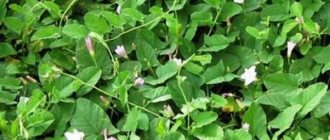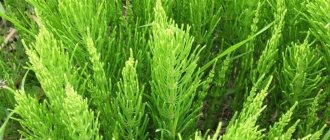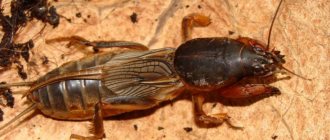What kind of hops are there?
Hops are a vine. It comes in two types: Japanese and ordinary.
Japanese hop, or climbing hop, is an annual plant. For this reason, it will not bring big trouble to the dacha plot. You planted it in the spring, it grew to the required four meters in the summer, dropped its leaves in the fall - and that’s it. If you don't like it, you don't plant it anymore.
Japanese hops
Not everything is so simple with another type of plant - ordinary or climbing hops. This is a perennial plant that can reach a height of 17 m! It can reproduce by seeds, cuttings, parts of rhizomes, and root shoots. There are female and male plants. In summer, cones containing seeds appear on the female ones.
Common hop
Herbicides
Any contact herbicide (Roundup, Hurricane, Tornado) allows you to quickly and permanently get rid of hops without heavy physical effort.
In dry, windless weather, carefully sprinkle the leaves of the hop to be destroyed with a herbicide solution. Any plants that are exposed to the herbicide dry out and die within 1-2 weeks.
To ensure the protection of neighboring plants, some gardeners inject a concentrated herbicide solution directly into the stem of the weed being killed using a syringe with a thick needle.
Why is hop dangerous?
One of the main advantages of hops is that in a short time it can entwine any vertical support and create protection, for example, from prying eyes in a gazebo or from the wind on a site. However, this ability has also become the main problem for those who grow hops. After all, it weaves not only the territories allocated to it, but also captures all the land that is free or occupied by less aggressive plants.
- 5 beautiful vines for a shady garden
Photos and descriptions of climbing bushes that do not require good lighting.
Hops are also found on the walls of houses. There it can cause even greater trouble: its small shoots penetrate into any cracks and irregularities and can cause damage and cracks in the walls.
How to kill hops with salt
In saline soil the plant does not develop and eventually dies. Therefore, table salt can effectively fight loaches.
There are several ways:
- Sprinkle table salt around the root. The thickness of the layer must be at least one centimeter;
- If the plant is old and has a thick trunk, then you need to make a hole in it and inject a saline solution using a syringe. To do this, you need to dilute salt in water in a ratio of 1 to 2;
- We cut off the green part, dig up the root and pour a solution of salt and diesel fuel into the recess in a ratio of 1 to 1.
Such methods also allow you to remove various weeds from the garden. Just don't use them near vegetables. After all, salt worsens the condition of the soil, so it will be difficult to grow anything in such an area.
How to get rid of hops forever?
What to do if hops have captured all imaginable and inconceivable territories and continue to march victoriously through your area? It's time to declare war on him! And in war, as you know, all means are good. Therefore, we will get rid of hops in the garden using folk methods and using scientific achievements.
How to grow hops in the yard?
Method 1 – shovel . The oldest and most labor-intensive option for getting rid of hops on the site. The deeper - at least 20-30 cm - you dig up the area where the aggressor grows, the greater the chances of defeating it. However, be prepared for the fact that young shoots will still appear here and there. Continue to uproot them without allowing them to grow back. Such a struggle will drag on for several years and will require a lot of patience and strength from you. However, this method, compared to others, is the most gentle and will not harm either the plants growing nearby or the soil.
Method 2 – salt . This option for controlling hops is only suitable in places where nothing but hops grows and you do not plan to plant or sow there in the coming years. Sprinkle at least 1 cm of salt near the roots. After a while, you will see that the vine has begun to wither. All you have to do is remove it and forget about hops like a bad dream.
Method 3 - frost . If your region has harsh winters, try to use this to your advantage. In the fall, dig up the soil near the plant, exposing its roots as much as possible. The colder the winter, the greater the chance that the rhizomes will be damaged and will not be able to come to life in the spring. This method can be used together with digging: what could not be dug up can be frozen.
Method 4 – fertilizers . Yes, yes, fertilizers. It is a well-known fact that everything useful, but taken in excess, becomes harmful. Let's try to take advantage of this. Take saltpeter and cover the entire area near the vine with a thick layer. Water well, because... This is an easily soluble fertilizer and after watering it will reach the roots faster. After some time, all the hop shoots will dry out. As in the case of salt, the area after a “killer” dose of fertilizer will be unsuitable for some time for growing vegetable and garden crops.
Method 5 - herbicides . Any approved continuous action herbicide can be used to destroy hops on the site. Chemicals can be used in several ways:
- watering at the root;
- spraying the leaves and stems of the plant;
- an injection that is injected directly into the root or stem of the hop.
The last option is the most gentle, because... The herbicide in this case destroys only the unwanted plant, but does not affect other crops growing in the neighborhood.
Method 6 – black film . The method, which many have already used more than once to control weeds, can also help in the case of hops. Its essence is to deprive the plant of access to light. And without light, as we know, not a single living organism can survive. Instead of film, you can use slate sheets, large pieces of metal, roofing felt, and a thick layer of any mulching material. The main thing is to reliably shelter the aggressor from sunlight. After some time he will give up.
Removing the plant
Having received unpleasant surprises from a beautiful ornamental plant, the gardener is forced to think about how to get rid of the harmful plant. This is not an easy task, but scientists and folk craftsmen have come up with 7 methods that have already proven themselves in practice.
Application of herbicides and pruning method
Several well-known drugs, for example, Tornado, Hurricane, Roundup, can prevent the spread of hops. These tools can be used in three ways:
- spray the drug on the leaves;
- pour it under the root system;
- inject directly into the root.
When choosing a specific method, you should take into account the features specified in the instructions for the drugs. The result of using each remedy will be withering and death of shoots and leaves. But neighboring plants may also be damaged. To prevent this from happening, you need to choose absolutely calm weather for the procedure, or resort to injecting the drug with a syringe directly into the root system, or pour it under the root. The optimal time for such operations is spring and summer.
The pruning method is the most humane method that allows you to uproot a plant at great depths. At the same time, even tiny shoots that can produce a “harvest” for next year should come into view.
The pruning rules are:
- cut the vine at the root every week;
- prevent shoot growth and seed formation;
- constantly loosen the soil.
READ ALSO: Original ideas for using toilet bushes: country tips
If hops have settled among berry bushes, it is recommended to temporarily move them to another area, clearing the root system of possible hop shoots.
Use of green manure and fertilizers
These plants are able to suppress the activity of weeds within a short time. If you sow crops such as clover, oats, peas, beans, buckwheat on the ground where hops have settled, their branched root system will not allow shoots of unwanted plants to rise to the top. After performing these functions, green manure is mowed and used as mulch.
It is important to observe moderation when using fertilizers. Ignoring this rule leads to the death of plants. In the case of hops, this effect is valuable. For example, if a large amount of fresh bird droppings or cow manure is added to the root, the hops will quickly lose their viability.
Unregulated use of saltpeter is also effective. Exceeding the norm is necessary, otherwise you can get the opposite result - the plant will begin to actively develop. It is advisable to carry out this procedure several times.
Freezing and darkening roots
This method is used as an additional method after trimming the hop root system. After removing the shoots, the hole is not filled with earth. When winter cold sets in, water is poured into it. Ice will form and freeze the remaining parts of the roots. In the spring they will not sprout.
Light is a necessary condition for the growth and development of any plant. Placing hops in constant darkness will kill them. To achieve this result, you can use a shelter. But first, the vines need to be cut at the root, covered with thick black film, slate sheets or other light-proof material. As a result, the owner will receive a plot of land free from the aggressor plant.
Folk remedies
Gardeners use not only official recommendations. Sometimes simple recipes invented by the farmers themselves help:
- To destroy hops, they use salt - they scatter it in a centimeter layer under the roots or inject salt solution directly into the trunks;
- salt in equal parts is mixed with diesel fuel and poured into depressions (20-30 cm) around the hop trunks;
- Each bush is scalded with a hot soda solution;
- additional small shoots are destroyed by spot cauterization with a blowtorch.
Before planting garden hops on your plot, you should inquire about its properties. It is unlikely that the decision will be in favor of a beautiful climbing plant if the gardener learns about its omnipresence. If this aggressor has already begun to seize the garden, it is worth studying proven methods of combating it and applying them in practice.
What are the benefits of hops?
For the sake of fairness, it is worth remembering that hops are a useful plant. It has long been used in brewing. Hop cones, thanks to the lupulin they contain, give the foamy drink a specific aroma.
Hops are also widely used in medicine. It is part of antidepressants and sedatives, such as Valocordin, Sedavit, etc.
- Be sure to plant: plants that help with insomnia
Plant these plants in your garden and you will always have a natural remedy to combat insomnia and stress at your fingertips.
This plant has not been ignored by culinary specialists either. Hops are added to salads and soups. It is used in the production of baked goods and wine.
Benefits and harms
Due to the fact that hops are a climbing plant, gardeners plant them to decorate fences, house walls and to create hedges, and also make magnificent arches from them. A huge advantage is the unpretentiousness of this loach and the fact that it can grow for many, many years.
The big disadvantage of ordinary hops is that it grows very quickly, taking over more and more land every year intended for growing vegetables and berries. In addition to taking over their territory, this weed prevents the growth of vegetable crops by entwining it.
It is almost impossible to get rid of it by ordinary pulling and weeding, since it reproduces by seeds, which are scattered throughout the garden.
If you don’t catch it in time and allow this weed to take over your vegetable bed, you can say goodbye to the future harvest.
If you still want to have a hedge of hops and not have to worry about growing them, it is better to pay attention to the Japanese species, which is not only an annual plant, but also, after dying, turns into an excellent fertilizer for vegetable crops. Many gardeners have recently preferred to decorate their plots with them.
How to properly plant hops on a plot?
Or maybe it’s worth making friends with this, as it turns out, useful plant? For hops to become your friend, you just need to follow some rules when planting and caring for them.
- Plant hops in areas where other plants do not grow. This could be the area along the fence, shady areas, or walls that look unattractive and want to be decorated.
- Immediately after planting, install underground barriers to control root growth. These can be sheets of slate, plexiglass or plastic, dug to a depth of at least 40 cm.
- Remove all male plants from the area. Females spend part of their energy on ripening seeds, so it is easier to “agree” with them. And the male ones - very active - quickly settle into new territories on your site, and it is not so easy to “drive” them out of there.
- Trim off all unnecessary shoots in a timely manner and do not allow the seeds to ripen. This will make it easier for you to control the spread of the plant in the area.
Growing hops in a summer cottage has both negative and positive aspects. If you nevertheless decide to have this plant in your dacha, keep it in check from the very beginning. Then it won't cause you much trouble.
Preventing the spread of hops - how to deal with it
To prevent planting hops from causing inconvenience, you can use some techniques to limit its spread. To do this, you should know that hop cones used in folk medicine and brewing are formed on female plants, so you can immediately pull out the males, the spread of which is extremely difficult to control. It's also worth learning more about how to control wheatgrass.
The second secret is to provide fences for the root system, which is located at a depth of 20 centimeters or more. By digging pieces of slate around the perimeter or using other suitable material, you don’t have to worry about its rapid growth. It is also necessary to think through limiting systems from above, for example, use garters, the height of which should be mercilessly cut off all protruding parts.
Planting hops on chain-link fences looks beautiful and cultural. Such a fence not only has a pleasant appearance, but is also an excellent protection against uninvited guests.
To avoid turning the fence into an impenetrable jungle, it is necessary to dig in limiting fences for roots on both sides. If the hops have outgrown the height of the fence, the shoots are pruned. It is very important to prune before the formation of buds and cones, if cultivation is not planned with the further collection of such a “harvest”. It will also be useful to learn about how to destroy horsetail, and what means should be used first.
On video -
It should also be noted that in addition to regular hops, there is also its Japanese counterpart. If the branches of a regular one are capable of growing up to 15 - 17 meters in a year, then such a plant will become a good competitor. Read how to get rid of maple trees on your property here.
Japanese hops are common in the Far East and Asia; they are distinguished by decorative leaves, but are smaller in size - only four meters long.
In addition, Japanese hops have another indisputable advantage - it is an annual, which means that next year you will not have to fight persistent offspring, and only you choose the place for the growth of this vine. But this material will help you understand how to get rid of dandelions, and which means are the most effective.











